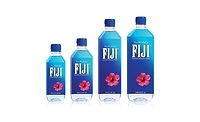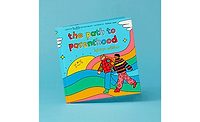Water, Water Everywhere
By JENNIFER KOROLISHIN
Bottled water category exhibits continued growth
Bottled water is one of
the fastest-growing categories in the beverage industry, occupying the No.
2 slot behind carbonated soft drinks. From single-serve to multi-gallon
formats, bottled water’s steady growth has meant strong sales across
major retail channels.
According to Information Resources Inc., in the 52
weeks ending June 12, 2005, dollar sales of convenience/PET still water are
up 15.9 percent over last year, for a total of more than $2.5 billion. Unit
sales, totaling nearly 1.1 billion, rose 8.1 percent during the same
period. Bottled water volume in 2004 was nearly 6.8 billion gallons, an 8.6
percent increase over 2003, according to other industry estimates. Per
capita consumption of bottled water reached 23.8 gallons last year,
compared to 22.1 gallons in 2003.
Given the general food industry trend toward healthful
product offerings, bottled water’s consumer appeal is easy to
understand.
“Consumers are a demanding group and
they’re looking for choices. Virtually any place you can buy other
packaged beverages, you’ll find bottled water,” says
International Bottled Water Association (IBWA) Vice President of
Communications Stephen Kay. “If consumers want to avoid or moderate
calories, caffeine, alcohol, sugars or artificial colors or flavorings,
they’re choosing bottled water because of its access and
convenience.”
Aquafina once again holds the industry’s top
spot, with more than $380 million in sales through supermarkets, drug
stores and mass merchandise outlets, and nearly 15 percent market share,
according to IRI. Close on its heels is private label water, with more than
$338 million in sales and 13.2 percent market share. And private label is
growing at a faster rate than any of the branded products in the Top 10,
with an almost 24 percent increase in dollar sales during the past year.
But the category as a whole performed admirably, with only one brand,
Evian, experiencing a sales loss, and even that was a scant 0.1 percent.
New choices
Flavored waters and vitamin-enhanced waters are among
the newest beverage choices on the market, but such products are not
technically considered to be bottled water. Bottled water is regulated by
the Food and Drug Administration as a packaged food product and governed by
standards of identity for classifications, including bottled, drinking,
artesian, mineral, purified, sparkling and spring water. Flavored waters
and enhanced waters fall outside the category because they typically
include sweeteners or colors.
Despite the differing definitions, IBWA doesn’t
seem concerned with the popularity of the new products. “I think
those products show that there’s definitely, led by bottled water,
consumer interest in water products. That includes not only the importance
of water for drinking, but they’re looking for additional tastes, new
experiences or attributes of the product,” Kay says.
| Top bottled waters by brand (convenience/still) | |||||
| Dollar sales | % Change vs. prior year | Market share | % Change vs. prior year | ||
| AQUAFINA | $380,607,300 | 0.6% | 14.9 | -2.3 | |
| PRIVATE LABEL | $338,280,300 | 23.7% | 13.2 | 0.8 | |
| DASANI | $300,771,400 | 9.4% | 11.8 | -0.7 | |
| POLAND SPRING | $173,789,200 | 21.4% | 6.8 | 0.3 | |
| PROPEL | $152,672,400 | 40.1% | 6.0 | 1.0 | |
| DANNON | $141,961,800 | 32.4% | 5.6 | 0.7 | |
| ARROWHEAD | $128,542,400 | 12.3% | 5.0 | -0.2 | |
| DEER PARK | $92,309,660 | 19.7% | 3.6 | 0.1 | |
| CRYSTAL GEYSER | $85,506,730 | 13.4% | 3.3 | -0.1 | |
| EVIAN | $75,690,460 | -0.1% | 3.0 | -0.5 | |
| CATEGORY TOTAL | $2,554,937,000 | 15.9% | 100.0 | 0.0 | |
| Source: Information Resources Inc. Total food, drug and mass merchandise, excluding Wal-Mart, for the 52 weeks ending June 12, 2005. | |||||
Of the new flavored options, Gatorade’s Propel
leads the way, with nearly $153 million in sales, up 40 percent over
prior-year sales. It is the fifth-largest bottled water brand overall.
Veryfine Fruit2O, which was purchased by Kraft Foods last year, had a sales
increase of more than 51 percent during the past year, for $58 million in
sales; and Glaceau’s Vitaminwater grew almost 115 percent for a total
of $38.4 million.
Product safety & technology
The vast majority of IBWA members, however, focus on
traditional bottled water, and the association supports members with
expertise and services surrounding those products.
Bottled water is regulated by numerous state and
federal laws, including a federal standard of quality, which establishes
limits for microbiological, physical, chemical and radiological substances
for both source water and finished bottled water products. Additionally,
IBWA bottler members must adhere to the IBWA Model Code, which in some
cases is more stringent than FDA, EPA or state regulations; it covers
critical areas including plant construction and design, sanitary facilities
and controls, sanitary operations, equipment and procedures, process and
controls and personnel.
As technology advances, bottled water producers are
also using new methods to detect and measure various substances to ensure
product safety.
“It’s a continued challenge to further
enhance product safety and quality, so as detection methods get better and
better, we’re also looking to bring sense to the world of
standards,” Kay says. “Just because you can detect something
doesn’t mean it’s harmful. A simple detection doesn’t
equal that it’s not in compliance. However, we support standards that
protect consumers, but it also doesn’t indicate that it’s not
harmful. And where public policy and protection of consumer health makes
sense, we support strong and fair standards.”
Legislative & regulatory issues
The bottled water industry faces a number of
regulatory and legislative issues, one of which is recycling. Along with other beverage-makers, IBWA supports curbside
recycling and encourages its members to get involved locally.
Resource management is
another major issue in the bottled water industry. “While people are
concerned that the bottled water industry is extracting too much water, we
are trying to communicate the data and the science about the issue to put
it in the proper context,” Kay says. “We really are a minimal
user of water resources and a responsible user, since 87 percent of the
groundwater extracted makes it into the bottle for drinking.”
Additionally, IBWA supports harmonization of state
laws with federal standards to avoid confusion and increase efficiencies.
As the bottled water category continues to grow, the
category’s outlook is decidedly upbeat. “We see continued
growth of bottled water. Consumers are not going to suddenly lose their interest in health and fitness and
they’re going to continue their demand,” Kay says. BI


